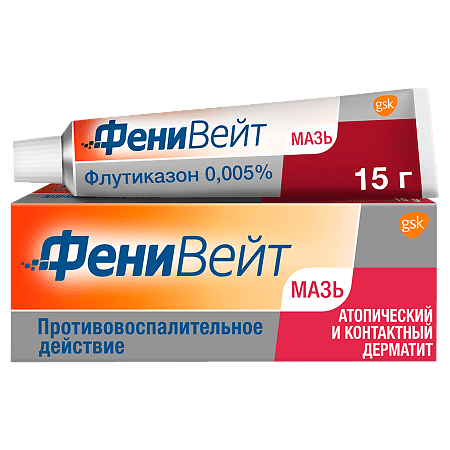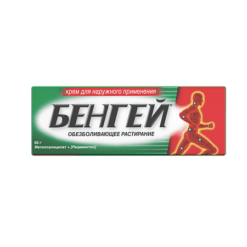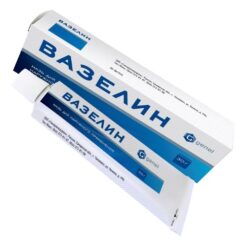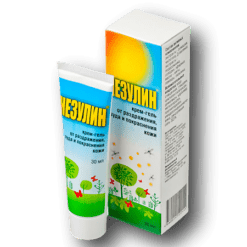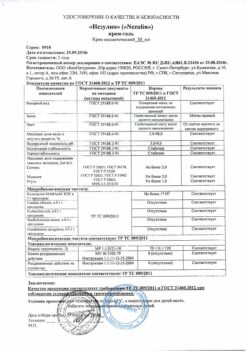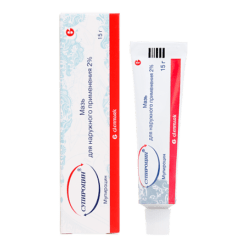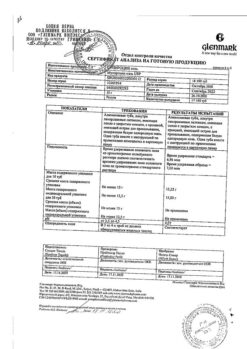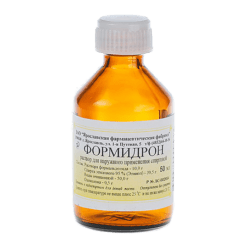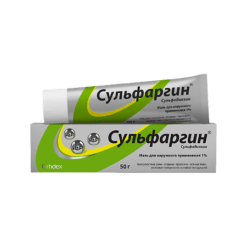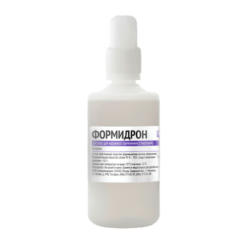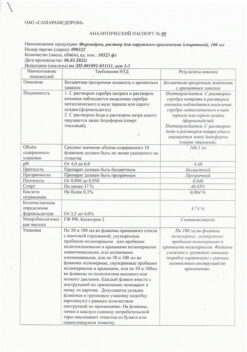No products in the cart.
FeniVeit, ointment 0.005% 15 g
€17.81 €14.84
Description
Due to limited absorption of fluticasone through the skin, the bioavailability of the drug when used externally is very low. The bioavailability of fluticasone when ingested is close to zero due to very low gastrointestinal absorption and extensive metabolism during “first passage” through the liver, which ensures low systemic exposure if the drug is accidentally swallowed.
Distribution
After entering the systemic bloodstream, fluticasone rapidly enters the bile and is excreted through the intestine. The degree of binding to plasma proteins is quite high (91%). Fluticasone does not accumulate in tissues and does not bind to melanin.
Metabolism
According to the results of preclinical and clinical studies, fluticasone has a high metabolic clearance with subsequent rapid excretion from the body. Thus, the drug, having entered through the skin into the systemic bloodstream, is quickly inactivated. The main route of metabolism is hydrolysis to carboxylic acid; this metabolite has very weak glucocorticosteroid and anti-inflammatory activity.
Elimation
The excretion rate of intravenously administered fluticasone propionate is linear over a dose range of 250 to 1000 µg and is characterized by a high blood plasma clearance (CL=1.1 L/min).
The maximum plasma concentrations are reduced by approximately 98% within 3-4 hours, and only low plasma concentrations have been associated with a final half-life of 7.8 hours. Renal clearance of fluticasone propionate is insignificant (
Pharmacodynamics
Mechanism of action
Glucocorticosteroids for external use have anti-inflammatory properties. The anti-inflammatory properties are due to multiple mechanisms of inhibition of the late phase of allergic reactions, including reduction of mast cell number, attenuation of eosinophil chemotaxis and activation, reduction of cytokine production by lymphocytes, monocytes, mast cells and eosinophils, and inhibition of arachidonic acid metabolism.
Fluticasone is a glucocorticosteroid (GCS) with a strong local anti-inflammatory effect. Fluticasone propionate is highly lipophilic, which allows it to penetrate the double lipid layer of the target cell and bind to glucocorticoid receptors in the cytoplasm.
In vitro studies have shown that fluticasone has high selectivity and affinity for glucocorticosteroid receptors.
The fluticasone propionate-receptor complex stimulates or inhibits iRNA transcription and subsequent protein synthesis. The production of enzymes responsible for the anti-inflammatory effect is increased while the production of inflammatory mediators is reduced.
The production of enzymes responsible for the anti-inflammatory action is increased while the production of inflammatory mediators is decreased. When applied to the skin, there is little possibility of suppression of hypothalamic-pituitary-adrenal system (GnA) function.
According to clinical studies, if fluticasone enters systemic blood flow, it is quickly transformed in the liver to inactive metabolite (17β-carboxylic acid) with subsequent rapid excretion from the body. Due to these properties FeniVeit has a high therapeutic index.
Pharmacodynamic effects
Fluticasone does not cause unforeseen hormonal disturbances and has no significant effect on the central and peripheral nervous system, gastrointestinal tract, cardiovascular and respiratory systems.
Indications
Indications
FeniVate, which contains the effective glucocorticosteroid fluticasone, is used in adults and children aged 10 years and older to relieve symptoms associated with atopic dermatitis (eczema), seborrheic dermatitis, accompanied by irritation or allergic contact dermatitis.
Pharmacological effect
Pharmacological effect
Due to the limited absorption of fluticasone through the skin, the bioavailability of the drug when used externally is very low. The bioavailability of fluticasone when taken orally is close to zero due to the very low level of absorption in the gastrointestinal tract and extensive first-pass metabolism through the liver, which ensures a low level of systemic exposure if the drug is accidentally ingested.
Distribution
After entering the systemic circulation, fluticasone quickly enters the bile and is excreted through the intestines. The degree of binding to plasma proteins is quite high (91%). Fluticasone does not accumulate in tissues and does not bind to melanin.
Metabolism
According to the results of preclinical and clinical studies, fluticasone has high metabolic clearance with subsequent rapid elimination from the body. Thus, the drug entering the systemic circulation through the skin is quickly inactivated. The main metabolic pathway is hydrolysis to carboxylic acid; this metabolite has very weak glucocorticosteroid and anti-inflammatory activity.
Removal
The elimination rate of intravenously administered fluticasone propionate is linear in the dose range from 250 to 1000 mcg and is characterized by high plasma clearance (CL = 1.1 l/min).
Peak plasma concentrations were reduced by approximately 98% within 3 to 4 hours, and only low plasma concentrations were associated with a terminal half-life of 7.8 hours. The renal clearance of fluticasone propionate is negligible (
Pharmacodynamics
Mechanism of action
Glucocorticosteroids for external use have anti-inflammatory properties. The anti-inflammatory properties are due to multiple mechanisms of inhibition of late phase allergic reactions, including reduction in mast cell numbers, attenuation of eosinophil chemotaxis and activation, reduction in cytokine production by lymphocytes, monocytes, mast cells and eosinophils, and inhibition of arachidonic acid metabolism.
Fluticasone is a glucocorticosteroid (GCS) with a pronounced local anti-inflammatory effect. Fluticasone propionate is highly lipophilic, which allows it to penetrate the lipid bilayer of the target cell and bind to glucocorticoid receptors in the cytoplasm.
In vitro studies have shown that fluticasone is characterized by high selectivity and affinity for glucocorticosteroid receptors.
The fluticasone propionate receptor complex stimulates or inhibits mRNA transcription and subsequent protein synthesis. The production of enzymes responsible for the anti-inflammatory effect increases while the production of inflammatory mediators decreases.
The production of enzymes responsible for the anti-inflammatory effect increases while the production of inflammatory mediators decreases. When applied to the skin, the likelihood of inhibiting the function of the hypothalamic-pituitary-adrenal axis (HPA) is negligible.
According to clinical studies, when fluticasone enters the systemic circulation, it is quickly transformed in the liver to an inactive metabolite (17β-carboxylic acid), followed by rapid elimination from the body. Thanks to these properties, the drug FeniVate has a high therapeutic index.
Pharmacodynamic effects
Fluticasone does not cause unexpected hormonal disturbances and does not have a significant effect on the central and peripheral nervous systems, gastrointestinal tract, cardiovascular and respiratory systems.
Special instructions
Special instructions
Manifestations of hypercortisolism (Cushing’s syndrome) and reversible inhibition of the HPA axis, leading to glucocorticoid insufficiency, in some cases occur due to increased systemic absorption of GCS for external use.
In such cases, it is necessary to gradually stop treatment, reducing the frequency of applications, or replace FeniVate with a less active GCS. Sudden cessation of treatment may lead to glucocorticoid insufficiency.
Risk factors for severe systemic reactions include the following:
activity and dosage form of GCS for external use;
duration of treatment;
application to large areas of the skin;
increased hydration of the stratum corneum of the dermis;
application to areas with thin skin such as the face;
damaged skin or other conditions potentially accompanied by damage to the skin barrier;
Compared to adults, children are likely to absorb more corticosteroids for external use, thereby increasing the risk of developing systemic adverse reactions. This is due to the immaturity of the skin barrier and the higher body surface area to body weight ratio in children compared to adults.
In children from 10 to 12 years of age, long-term continuous therapy with GCS for external use should be avoided if possible, as there is a possibility of suppression of adrenal function.
Cases of visual impairment have been reported with the use of systemic and local corticosteroids, resulting from increased systemic availability and direct eye contact.
Therefore, if a patient has symptoms such as blurred vision or other visual disturbances, consideration should be given to referring the patient to an ophthalmologist to evaluate possible causes, which may include cataracts, glaucoma, or rare diseases such as central serous chorioretinopathy (CSCR).
Long-term application of FeniVate ointment to the facial area is undesirable, since the skin in this area is more susceptible to atrophic changes. When applying FeniVate ointment to the eyelids, it is necessary to ensure that the drug does not get into the eyes, since repeated contact of the drug with the mucous membrane of the eye can lead to the development of cataracts and glaucoma.
In case of secondary infection of skin lesions, appropriate antibacterial therapy must be prescribed. If signs of infection spread, GCS for external use should be discontinued and appropriate antibacterial therapy should be prescribed.
Topical corticosteroid therapy is sometimes used to treat dermatitis that develops around chronic leg ulcers. However, this may be associated with a higher incidence of local hypersensitivity reactions and infectious complications.
Obvious inhibition of HPA axis function (morning plasma cortisol level less than 5 mcg/dL) in adults is unlikely when using PheniVate in recommended doses, except when the drug is applied to more than 50% of the body surface area and in an amount of more than 20 g per day.
Impact on the ability to drive vehicles and operate machinery
No studies have been conducted to evaluate the effect of PheniVate on the ability to drive vehicles or operate machinery. Based on the profile of adverse reactions of the drug FeniVate, no adverse effects on driving vehicles and machinery are expected.
Active ingredient
Active ingredient
Fluticasone
Composition
Composition
Active ingredient:
Fluticasone propionate (micronized) – 0.05 mg;
Excipients:
Propylene glycol – 50.00 mg;
Sorbitan sesquioleate – 5.00 mg;
Microcrystalline wax – 250.00 mg;
Liquid paraffin – up to 1.00 g.
Pregnancy
Pregnancy
Fertility
There are no available data to assess the effect of topical corticosteroids on human fertility. In animal studies, there was no effect of fluticasone propionate on fertility.
Pregnancy
There is limited data on the use of fluticasone during pregnancy. In animal reproductive studies, adverse effects characteristic of strong corticosteroids were observed only at high levels of systemic exposure.
As a result of preclinical studies, it was revealed that external use of corticosteroids in pregnant animals can cause deviations in embryonic development, however, the significance of this phenomenon in humans has not been established.
The use of the drug during pregnancy is not recommended, except in cases where the benefit to the mother outweighs the potential risk to the fetus and only under medical supervision. Before use during pregnancy, you should consult your doctor. In this case, the ointment should be applied in a minimal amount for the shortest period of time sufficient to produce a clinical effect.
Breastfeeding period
The safety of GCS therapy for external use during breastfeeding has not been established.
There are no available data to confirm the possibility of systemic absorption of GCS for external use in a volume sufficient for their detection in breast milk.
As a result of preclinical studies, it was revealed that during breastfeeding, when administered subcutaneously in quantities sufficient to be detected in plasma, fluticasone was found in milk.
The use of the drug during breastfeeding is not recommended, except in cases where the expected benefit to the mother outweighs any possible risks to the child. Before use during breastfeeding, you should consult your doctor.
When using the drug during breastfeeding, the drug should not be applied to the mammary glands to prevent accidental ingestion by the child.
Contraindications
Contraindications
Hypersensitivity to the active substance or any other component included in the drug;
Skin infections without prescribed therapy;
Primary skin lesions of bacterial, viral and fungal etiology;
Rosacea;
Acne vulgaris;
Perioral dermatitis;
Perianal and genital itching;
Itching without symptoms of inflammation;
Children’s age up to 10 years.
Do not apply to closed areas of the skin (for example, diaper rash or under occlusive dressings).
With caution:
Renal failure, liver failure, old age, childhood (10 to 12 years).
Side Effects
Side Effects
The adverse reactions presented below are listed according to the damage to organs and organ systems and the frequency of occurrence. The frequency of occurrence is defined as follows: very often (≥ 1/10), often (≥ 1/100 and
Frequency of occurrence of adverse reactions
Infectious and parasitic diseases: Very rare – Opportunistic infections.
Immune system disorders: Very rare – Hypersensitivity*: itching at the site of application, rash, swelling.
Endocrine system disorders (HPA axis inhibition): Very rare – Weight gain or obesity; Slow weight gain or growth retardation in children; Cushingoid features (eg, moon face, central obesity); Decrease in the concentration of endogenous cortisol; Hyperglycemia or glycosuria; Arterial hypertension; Osteoporosis; Cataract; Glaucoma.
Skin and subcutaneous tissue disorders
Often – Itching at the site of application of the ointment.
Uncommon – Burning at the application site.
Very rare – Thinning of the skin, atrophy, stretch marks, telangiectasia, pigmentation changes, hypertrichosis, allergic contact dermatitis, exacerbation of symptoms of the underlying disease, pustular psoriasis, erythema, rash, urticaria.
* Local hypersensitivity reactions may resemble symptoms of the disease for which this therapy is used.
You should inform your doctor if any of the adverse reactions listed above occur. The decision on further treatment strategy must be made by the doctor.
If any of the adverse reactions indicated in the instructions worsen, or you notice any other adverse reactions not listed in the instructions, tell your doctor.
Interaction
Interaction
Concomitant therapy with drugs that have an inhibitory effect on the CYP3A4 isoenzyme (for example, ritonavir, itraconazole) can lead to inhibition of the metabolism of GCS, which is accompanied by increased systemic exposure.
The degree of clinical significance of such interactions depends on the activity of the CYP3A4 isoenzyme inhibitor, the dose and route of administration of GCS, however, such an interaction is unlikely when used externally.
Overdose
Overdose
Symptoms
When used externally, fluticasone can be absorbed in sufficient quantities to exhibit systemic action. The likelihood of an acute overdose is extremely low, however, with chronic overdose or improper use of the drug FeniVate, signs of hypercorticism (Cushing’s syndrome) may develop.
Treatment
In case of an overdose of fluticasone, discontinuation of the drug is carried out gradually – by reducing the frequency of its application or switching to a less active GCS to avoid the risk of developing glucocorticoid insufficiency. If a clinical picture of a drug overdose develops, symptomatic therapy is indicated.
Manufacturer
Manufacturer
GlaxoSmithKline Pharmaceuticals S.A., Poland
Additional information
| Manufacturer | GlaxoSmithKline Pharmaceuticals S.A., Poland |
|---|---|
| Medication form | topical ointment |
| Brand | GlaxoSmithKline Pharmaceuticals S.A. |
Related products
Buy FeniVeit, ointment 0.005% 15 g with delivery to USA, UK, Europe and over 120 other countries.

